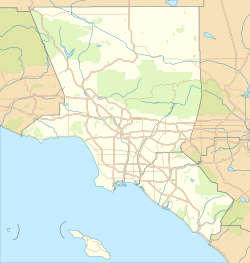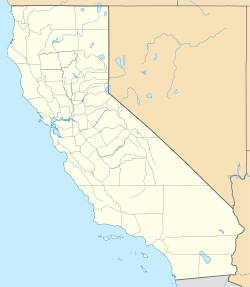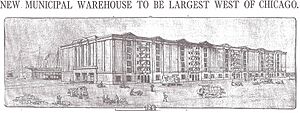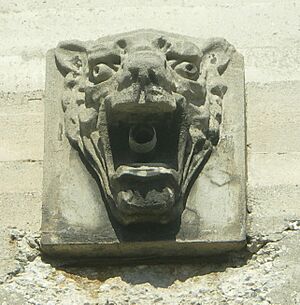Municipal Warehouse No. 1 facts for kids
Quick facts for kids |
|
|
Municipal Warehouse No. 1
|
|
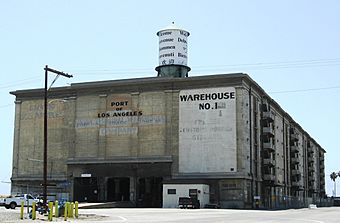
Municipal Warehouse No. 1 in 2008
|
|
| Location | 2500 Signal St., San Pedro, California |
|---|---|
| Architect | Peter Ficker |
| NRHP reference No. | 00000386 |
| Added to NRHP | April 21, 2000 |
Municipal Warehouse No. 1 is a large, six-story building. It was built in 1917 at the edge of the main channel in the Port of Los Angeles. This warehouse was very important for making Los Angeles a major center for world trade. Because of its role in developing trade, it is now listed on the National Register of Historic Places.
Contents
Building a Giant Warehouse
After the Panama Canal opened in 1914, leaders in Los Angeles had big plans. They believed that if they built modern port facilities, many ships would come to Los Angeles. World War I delayed some plans, but the city still wanted a large warehouse. This warehouse would handle all the goods expected to arrive after the war.
By late 1914, work began on a six-story warehouse. The Harbor Commission showed off the plans for this "mammoth new warehouse." The Los Angeles Times newspaper reported on its design. They said it would be a huge, fireproof building. It was designed to be strong and useful, not just pretty.
The warehouse was built from reinforced concrete. It was 480 feet (150 m) long and 150 feet (46 m) wide. This made it the biggest building of its kind west of Chicago. It was planned to stand at the very end of the city's large outer harbor dock.
The final cost of the warehouse was about $475,792.53. This was almost double the first guess. The building needed over 27,000 cubic yards of cement. It also used 1,200 tons of steel. This made it the largest structure of its type on the Pacific Coast. Construction started in August 1915. It was slowed down by shortages during the war.
When Municipal Warehouse No. 1 opened in April 1917, many business people visited it. They learned how it could help their businesses. Ships would bring freight, which would be sorted. Then, electric trucks would move it into the warehouse. Sixteen electric hoists lifted the goods to different floors.
The warehouse had almost twelve acres of floor space. Businesses could rent this space. Goods could be prepared for shipping right there. They could then be sent directly by train. Train tracks ran into the warehouse. Elevators moved goods from the upper floors to loading areas in the basement.
This warehouse was the Port's only bonded warehouse for many years. It was very important in making the Port of Los Angeles a major international trade center. The 475,000-square-foot (44,100 m2) building had an inside area for 24 freight cars.
Rooftop Views and Operations
The roof of the warehouse offers amazing views of the harbor. Because of this, it has been used for different operations for a long time.
In the early 1920s, the Marine Exchange used the roof. They watched ships entering and leaving the port. In 1925, the Radio Corporation of America (RCA) put its harbor receiving station on top of the warehouse.
A new lookout station for the Marine Exchange was built in 1928. It had a large round window. This window allowed telescopes to have a great view of the harbor and ocean. It also had a neon red light that glowed at night.
In 1939, the Los Angeles Times described the Exchange as "a world all its own." Three men worked there in eight-hour shifts. They climbed seven flights of stairs to reach the station. The newspaper said one man sat at a desk with a large telescope. He could point it in any direction to watch the channel and harbor.
During World War II, the Marine Exchange stopped operations. This was due to blackout rules along the coast. But they started watching again in late 1945. In 1964, a new 26 feet (7.9 m) by 32-foot (9.8 m) platform was built for the Marine Exchange. The roof was also used for weather observations for many years.
A Hub for Trade and History
During World War II, the warehouse was used by the United States Navy. It served as a supply depot. After the war, it went back to civilian use. In September 1949, the fourth foreign trade zone in the United States was set up here. This followed successful zones in New York, New Orleans, and San Francisco.
From 1949 to 1956, the warehouse was like a "foreign island." Goods could be handled, sorted, and re-exported there. No taxes were paid unless they were brought into the United States. By 1950, over 100,000 local people worked in foreign trade. This trade brought in $530 million. The Los Angeles Foreign Trade Zone at Municipal Warehouse No. 1 helped Los Angeles become a major world trade center.
Over the years, many unusual items were stored in the warehouse. In 1949, a group of camels from Australia stayed there. They were waiting to meet quarantine rules for a Shriners convention. Also, a museum imported the railroad car that carried Winston Churchill's body after his death. This railcar was stored in Municipal Warehouse No. 1 for many years.
In the 1970s, new ways of shipping cargo in large containers changed things. This made the old way of warehousing less needed. But Municipal Warehouse No. 1 is still used as a bonded warehouse today. It also acts as a landmark for ships entering the Port. In 2000, Municipal Warehouse No. 1 was added to the National Register of Historic Places. This was because of its important role in international trade along the Pacific Coast.
Images for kids


